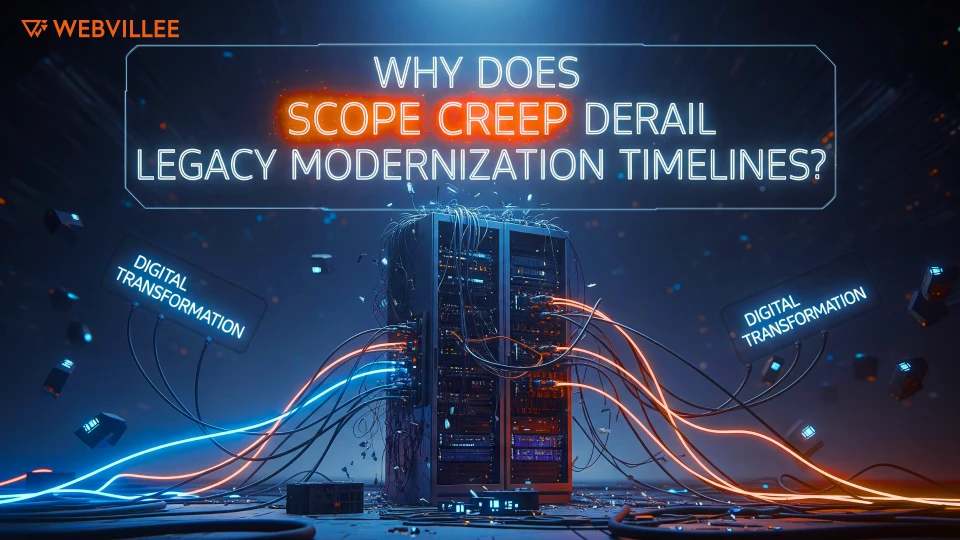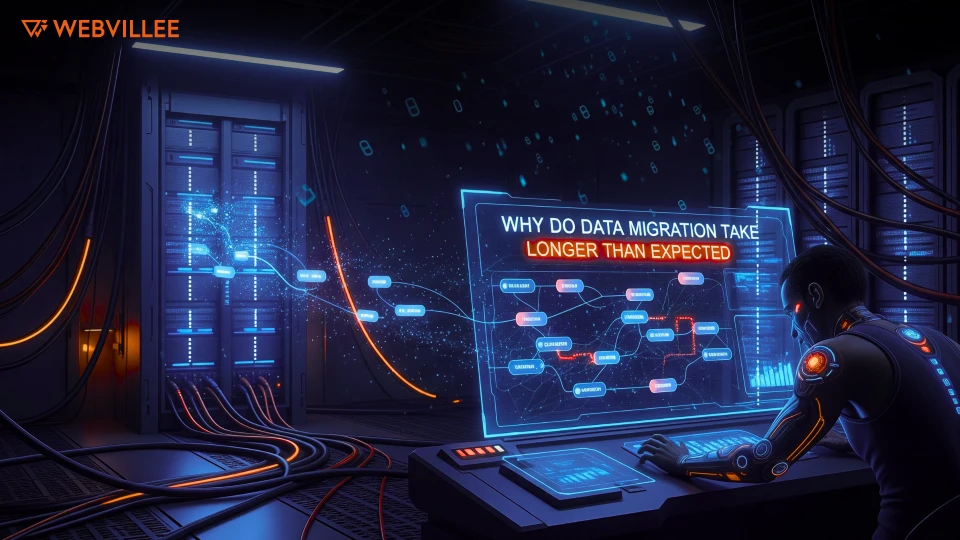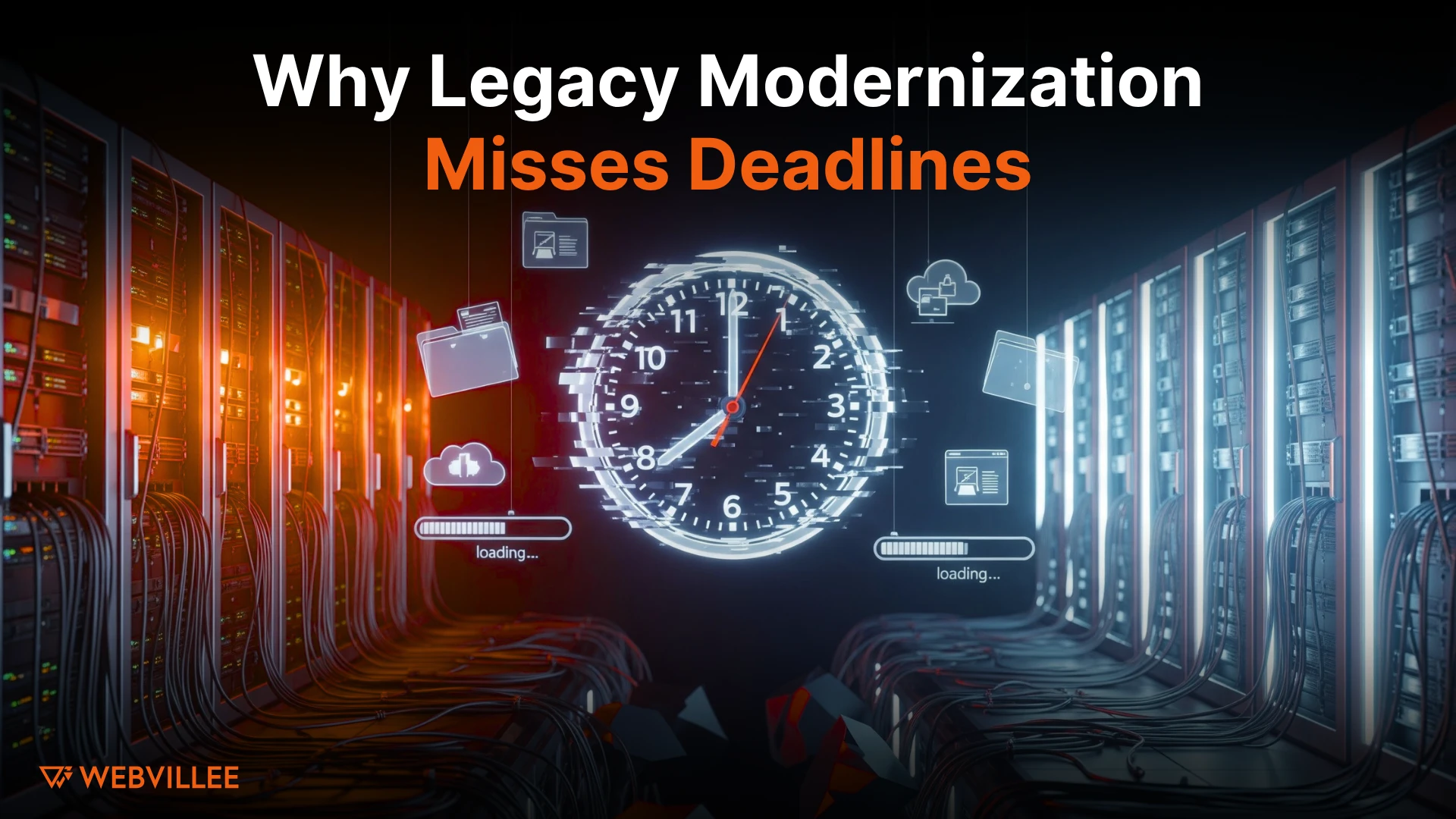The Hidden Costs of Outdated Systems
Legacy system modernization deadlines are missed in 67% of projects, costing organizations millions in budget overruns and lost productivity. The root causes are clear: underestimated complexity, poor planning, and inadequate stakeholder alignment consistently derail even well-intentioned modernization projects.
Understanding why these timeline failures happen is the first step toward prevention. The problem isn’t just technical but involves resource allocation, organizational readiness, and data challenges that surface only after projects begin.
This article examines five critical factors that cause legacy modernization projects to miss their deadlines and provides actionable strategies to keep your initiative on track.
What Makes Legacy System Complexity So Hard to Estimate?
Organizations consistently underestimate technical debt, undocumented dependencies, and integration points when planning legacy system modernization. What appears straightforward during initial assessments often reveals layers of complexity once teams begin actual implementation.
The core issue is visibility. Legacy systems accumulate years of patches, workarounds, and custom modifications that exist outside formal documentation. When your team starts mapping dependencies, they discover connections between systems that nobody remembers creating.
Hidden complexity factors include:
- Undocumented APIs and data flows between applications
- Custom code modifications made by former employees
- Third party integrations that lack current vendor support
- Database schemas that evolved without proper change management
Technical debt compounds this challenge. Each quick fix or temporary solution adds to the system dependencies that must be addressed during modernization. What looked like a six month timeline suddenly requires additional months just to untangle these connections.
Integration challenges emerge as another underestimated factor. Your legacy system likely communicates with dozens of other applications, each requiring careful consideration during the Digital Transformation process. Testing these integration points takes significantly longer than most initial estimates account for.
Why Does Scope Creep Derail Legacy Modernization Timelines?
Initial requirements rarely capture the full business process landscape, leading to continuous additions that push deadlines further out. Scope creep occurs when stakeholders realize the modernization affects more workflows than originally mapped.
The problem starts during discovery. Teams focus on primary functions while missing secondary processes that depend on the legacy system. Once migration begins, users identify these gaps and request additions to avoid business disruption.
Common sources of scope expansion:
- Business units discovering affected processes after kickoff
- Compliance requirements that weren’t initially documented
- Integration needs with systems not included in the original scope
- Feature requests from stakeholders who joined late
Requirement changes accelerate as the project progresses. What began as a straightforward system replacement evolves into a comprehensive business process redesign. Each new requirement adds development time, testing cycles, and potential integration complexity.
Stakeholder additions create another challenge. As word spreads about the modernization project, different departments request features or modifications to support their specific needs. These project delays accumulate quickly, especially when new requests require reworking completed components.
Feature expansion mid project is difficult to control without strong governance. Teams feel pressure to accommodate reasonable requests, particularly when stakeholders frame them as essential rather than optional. This pattern of continuous additions is why scope management remains the top cause of missed legacy system modernization deadlines.

How Do Resource Constraints Impact Modernization Deadlines?
Teams lack specialized skills for both legacy and modern systems simultaneously, creating bottlenecks that extend timelines beyond original estimates. This skill gap affects every phase from planning through implementation.
Your modernization project requires people who understand the old system deeply while also possessing expertise in new technologies. Finding individuals with both skill sets is challenging, and splitting responsibilities between separate teams creates coordination overhead.
Resource constraint challenges:
- Limited availability of developers familiar with legacy languages
- Competition for cloud architecture and modern framework expertise
- Knowledge transfer bottlenecks when legacy system experts leave
- Vendor dependencies for specialized migration tools or consulting
Specialized expertise becomes critical during complex migrations. You need architects who can design the new system, developers who can build it, and engineers who understand data migration at scale. Hiring or contracting these resources takes time and often costs more than budgeted.
Vendor dependencies add another layer of complexity. Many organizations rely on external consultants for specialized knowledge, but coordinating schedules and ensuring quality work extends timelines. When key vendors face their own resource constraints, your project waits.
Knowledge transfer represents a hidden resource challenge. Legacy system experts must document processes while simultaneously supporting daily operations and assisting the modernization team. This triple burden often means critical knowledge gets captured slowly or incompletely, causing rework later.
What Role Does Poor Change Management Play in Project Delays?
User resistance and inadequate training create implementation roadblocks that weren’t planned for in original timelines. Change management failures cause delays even when the technical work proceeds smoothly.
Organizations focus heavily on technical execution while underestimating the human side of system transitions. Employees comfortable with existing processes resist new workflows, particularly when training is rushed or incomplete. This organizational resistance manifests as slow adoption, workarounds, and requests to maintain old system access longer than planned.
Change management factors affecting deadlines:
- Staff pushback against new interfaces and processes
- Insufficient training time allocated in project plans
- Leadership underestimating the cultural shift required
- Parallel system operation extending beyond planned cutover dates
Training inadequacy compounds adoption challenges. Users receive brief sessions on new functionality but lack hands on practice time before go live. When they struggle post launch, IT teams must provide extensive support that pulls resources from other project phases.
User adoption timelines are consistently underestimated. Even with good training, people need weeks or months to reach full productivity with new systems. During this transition, many organizations run legacy and modern systems in parallel, creating dual maintenance burdens that weren’t budgeted.
Leadership commitment makes the difference between smooth transitions and prolonged delays. When executives actively champion the change and hold teams accountable for adoption, resistance decreases. Without this support, modernization projects drift as stakeholders debate whether to fully commit to the new system.
Why Do Testing and Data Migration Take Longer Than Expected?
Data quality issues and integration testing are discovered late in the process, requiring extensive rework that pushes final deployment dates back significantly. These technical challenges surface only after teams commit substantial time to development.
Testing delays occur because legacy data rarely meets modern system standards. You discover formatting inconsistencies, duplicate records, and validation errors only when migration scripts run. Cleaning this data takes weeks or months longer than initial estimates assumed.
Common testing and migration challenges:
- Data inconsistencies across decades of legacy records
- Integration testing revealing unexpected system behaviors
- Performance issues that require architecture changes
- Rollback planning consuming more time than anticipated
Data migration complexity grows with system age and size. Each table requires mapping, transformation rules, and validation checks. When your team encounters data that doesn’t fit new schema requirements, they must decide whether to modify the target system, transform the data, or exclude problematic records.
Integration testing uncovers issues that unit tests miss. Systems that work independently often fail when connected to other applications. These data quality issues require coordination across multiple teams, extending timelines as everyone works through their backlogs.
Rollback planning becomes critical as go live approaches. Teams must ensure they can revert to legacy systems if major issues emerge, which means maintaining parallel infrastructure and data synchronization. This safety requirement adds complexity and extends the period before legacy systems can be fully decommissioned.

How Can You Keep Your Legacy Modernization Project on Track?
Phased approaches with clear milestones, dedicated resources, and continuous stakeholder communication prevent most delays by managing complexity incrementally. Breaking large modernization efforts into smaller, measurable stages reduces risk and provides regular opportunities to adjust course.
A successful modernization strategy starts with realistic scoping. Map all system dependencies before committing to timelines, and include buffer time for discovered complexity. Assign dedicated resources rather than relying on staff juggling multiple priorities.
Practical strategies to meet deadlines:
- Break the project into phases: Modernize components independently rather than attempting full system replacement at once
- Establish clear project milestones: Define measurable goals for each phase with specific success criteria
- Maintain transparent communication: Provide regular updates to stakeholders about progress, risks, and timeline adjustments
- Invest in comprehensive testing: Allocate 30 to 40 percent of project time for testing and data validation
- Secure executive sponsorship: Ensure leadership actively supports the initiative and addresses roadblocks quickly
Risk mitigation requires continuous monitoring. Track actual progress against estimates weekly, and address variances immediately rather than hoping they resolve themselves. When delays occur, communicate them early with proposed solutions.
Stakeholder alignment throughout the project prevents scope creep. Establish a formal change control process where new requests are evaluated against timeline and budget impacts. This doesn’t mean refusing all changes but rather making informed decisions about what’s essential versus what can wait for future phases.
Moving Forward with Realistic Expectations
Legacy system modernization deadlines are missed because organizations underestimate complexity, allow unchecked scope expansion, face resource constraints, neglect change management, and discover data issues late in the process. Understanding these five factors helps you plan more realistic timelines and allocate appropriate resources.
Successful legacy modernization success requires balancing ambition with pragmatism. The organizations that meet their deadlines are those that invest time in thorough planning, maintain disciplined project management, and adapt their approach based on lessons learned during implementation.
Timeline management improves when you treat modernization as a strategic initiative rather than a technical project. This means securing executive commitment, dedicating skilled resources, and accepting that thoughtful execution matters more than aggressive deadlines.
Ready to modernize your legacy systems without the typical delays? Get in touch with Webvillee to explore solutions tailored to your business needs and timeline requirements.

